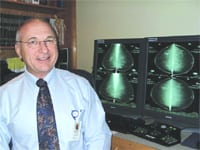U.S. Takes Aim At Stroke And Heart Disease
Heart disease and stroke — the principal components of cardiovascular disease — are the first and third leading causes of death in the United States, accounting for nearly 40{06cf2b9696b159f874511d23dbc893eb1ac83014175ed30550cfff22781411e5} of all deaths. About 950,000 Americans die of cardiovascular disease each year, which amounts to one death every 33 seconds.
Many people believe that heart disease and stroke primarily affect men and older people, but they are the leading causes of death for both men and women. Although these largely preventable conditions are more common among people age 65 years or older, the number of sudden deaths from heart disease among people age 15 to 34 has increased.
Moreover, deaths are only part of the picture. About 61 million Americans live with cardiovascular disease. Coronary heart disease is a leading cause of premature, permanent disability in the U.S. workforce. Stroke alone accounts for disability among more than 1 million Americans. Almost 6 million hospitalizations each year are due to cardiovascular disease.
The economic impact of cardiovascular disease on the U.S. health care system continues to grow as the population ages. The annual cost of heart disease and stroke in the United States is about $351 billion, including health care expenditures and lost productivity from death and disability.
Two of the major independent risk factors for cardiovascular disease are high blood pressure and high blood cholesterol. About 90{06cf2b9696b159f874511d23dbc893eb1ac83014175ed30550cfff22781411e5} of middle-aged Americans will develop high blood pressure in their lifetime, and nearly 70{06cf2b9696b159f874511d23dbc893eb1ac83014175ed30550cfff22781411e5} of people with high blood pressure do not have it under control.
A key strategy for addressing these risk factors is to educate the public and health care practitioners about the importance of prevention. For example, health care practitioners should be encouraged to follow the current guidelines (e.g., prescribing beta blockers and aspirin as appropriate) for treating patients with or at risk for cardiovascular disease.
People also need to be educated about the signs and symptoms of heart attacks and stroke and the importance of calling 911 quickly. Nearly 70{06cf2b9696b159f874511d23dbc893eb1ac83014175ed30550cfff22781411e5} of heart disease deaths occur before a person can be admitted to a hospital, and about 48{06cf2b9696b159f874511d23dbc893eb1ac83014175ed30550cfff22781411e5} of stroke victims die before emergency medical personnel arrive.
Other ways that people can reduce their risk for heart disease and stroke are to avoid using tobacco, adopt healthier diets, and be physically active. Using tobacco directly affects heart disease and stroke risk, and poor nutrition and physical inactivity adversely affect blood pressure and blood cholesterol levels.
In 1998, the U.S. Congress funded the Centers for Disease Control and Prevention (CDC) to launch a nationwide effort to help states develop the capacity, commitment, and resources necessary for a comprehensive program to prevent death and disability from heart disease and stroke, and to improve the cardiovascular health of all Americans.
Program priorities include: preventing and controlling high blood pressure and high blood cholesterol levels; improving quality of care to prevent and manage high blood pressure, stroke, and heart disease; getting people to appropriate emergency care quickly; eliminating health disparities based on geography, sex, race,thnicity, or income; and promoting heart health in health care facilities, work sites, schools, and communities through education, policy, and environmental changes.
To improve hospitals’ delivery of the critical emergency care that can prevent permanent disabilities from stroke, the CDC established the Paul Coverdell National Acute Stroke Registry in 2001 by funding four sites (Massachusetts, Georgia, Ohio, and Michigan) to design and test prototypes for registries to measure the delivery of acute care for stroke. In 2002, the CDC expanded funding to an additional four sites. All eight are developing prototypes for statewide, hospital-based registries.
The CDC will continue its work to prevent death and disability from heart attack and stroke and to eliminate disparities in health care. These efforts include promoting policy changes such as universal 911 coverage. The CDC will also continue to increase the number of states that are funded to develop heart disease and stroke prevention programs until every American is served.
Dr. Julie Louise Gerberding is director of the Centers for Disease Control and Prevention.




Comments are closed.